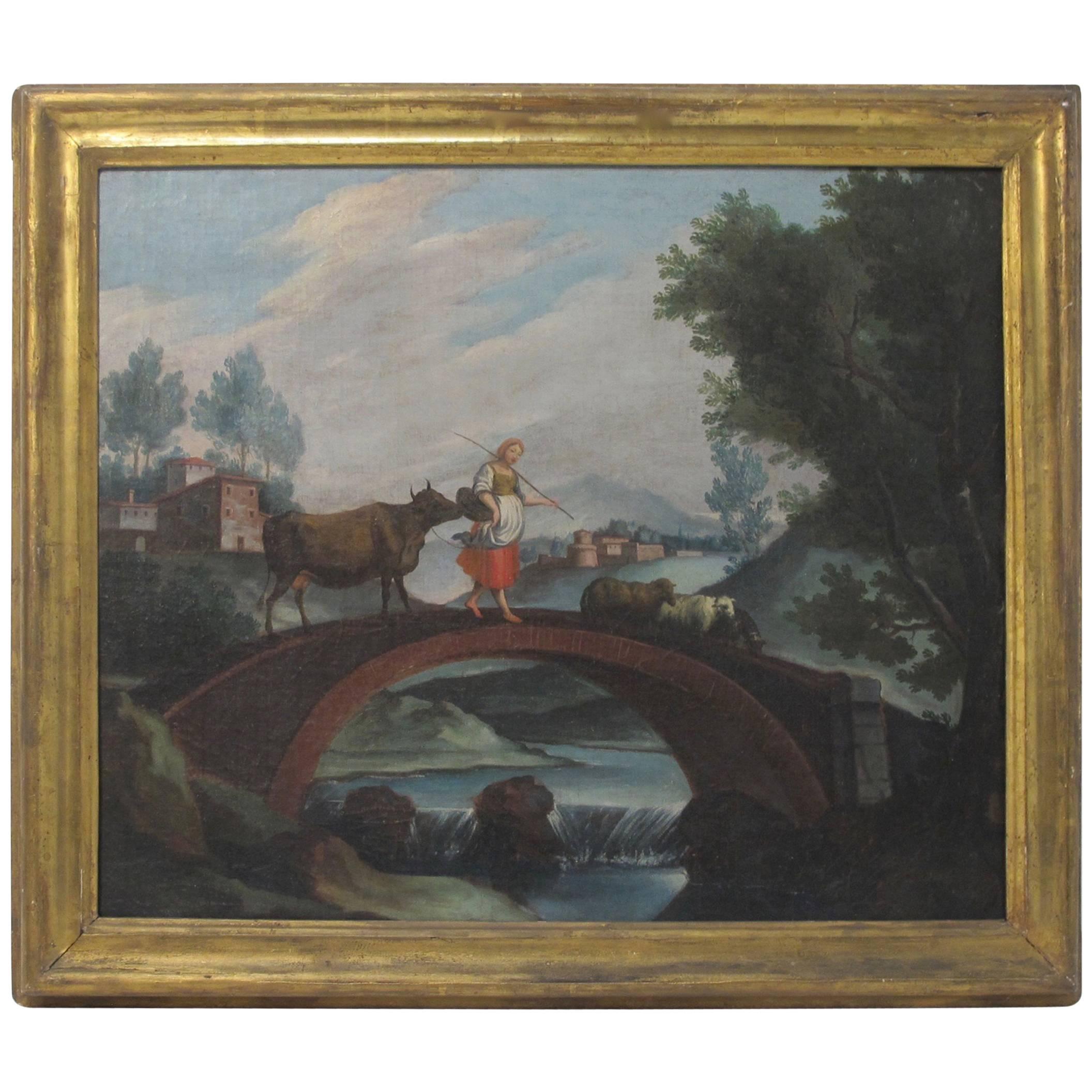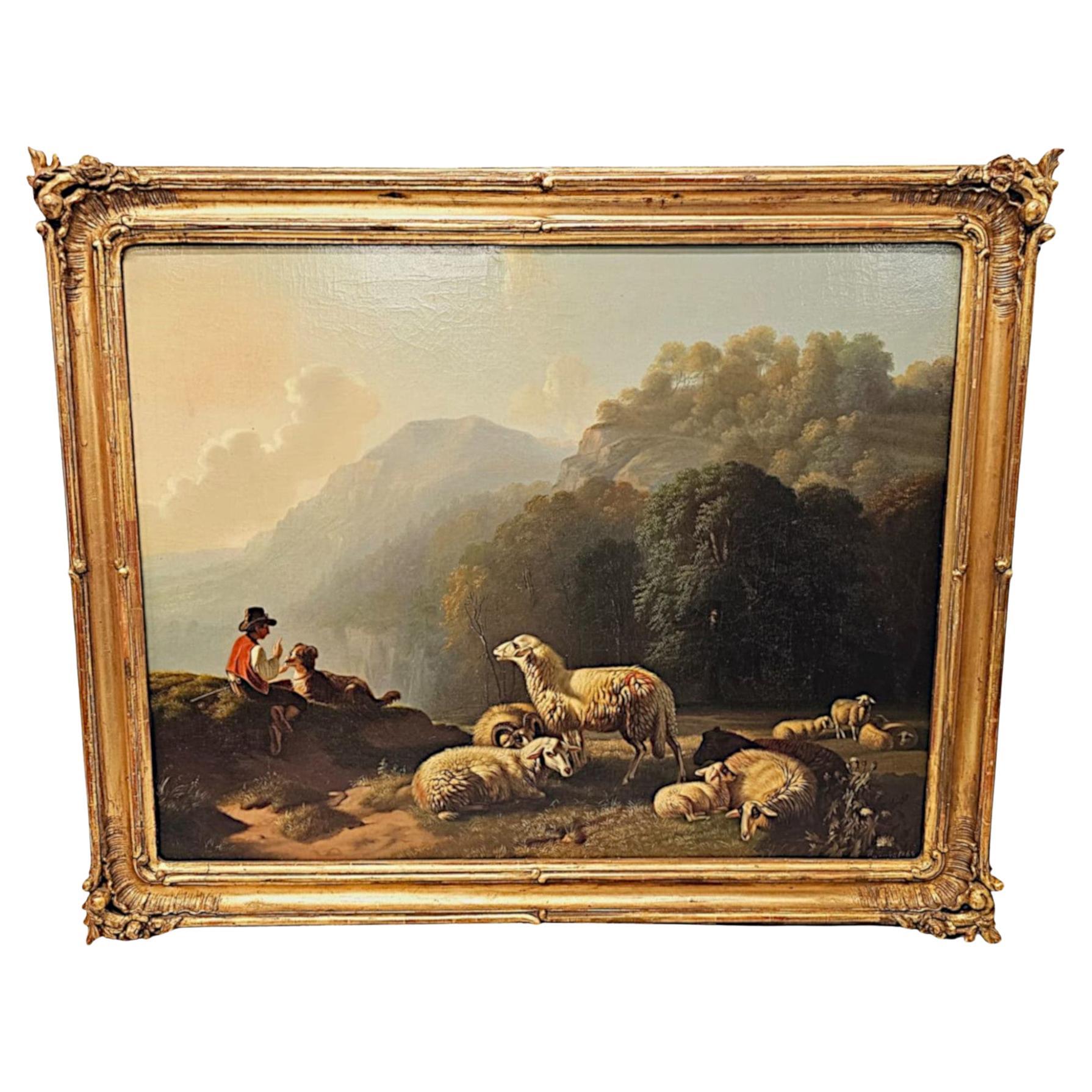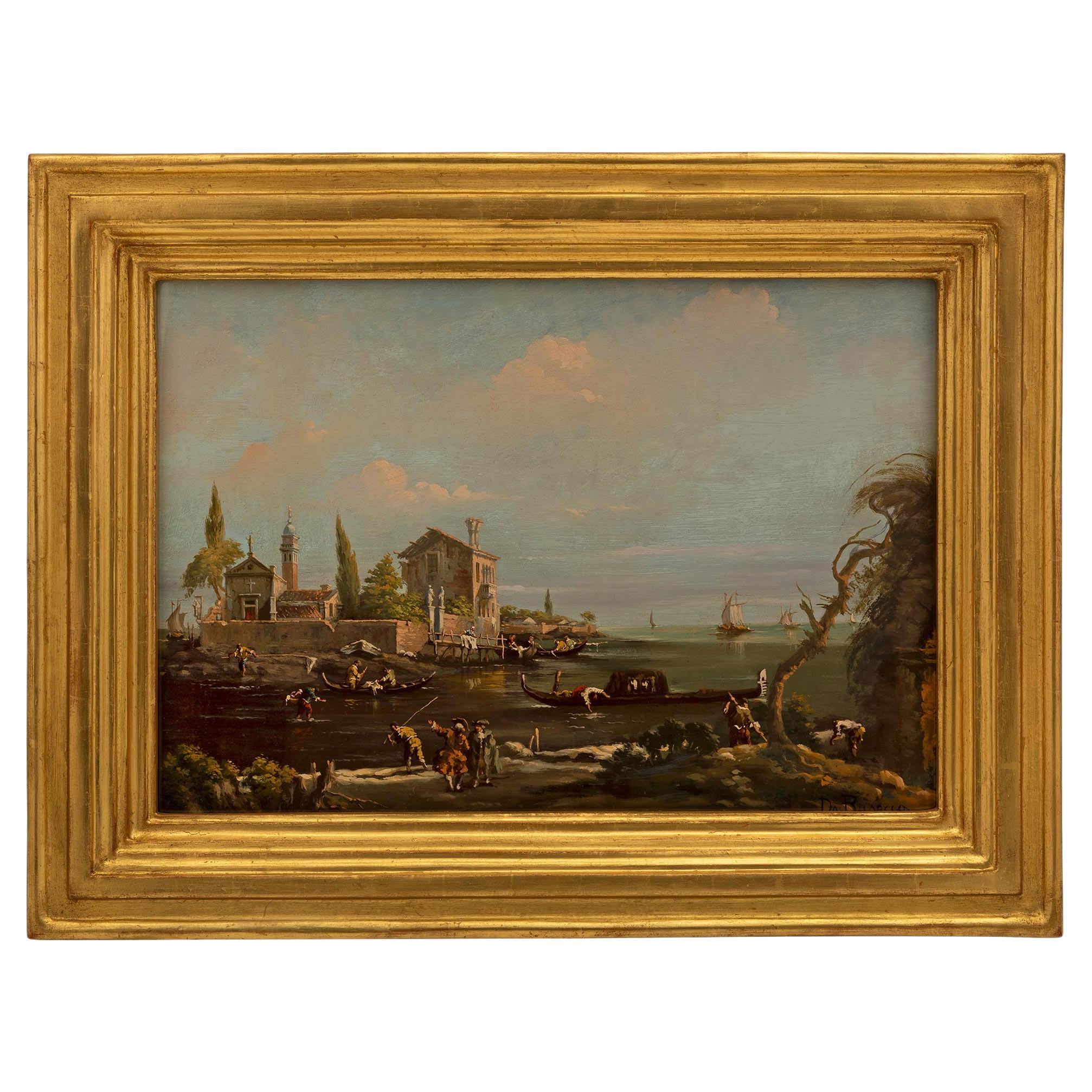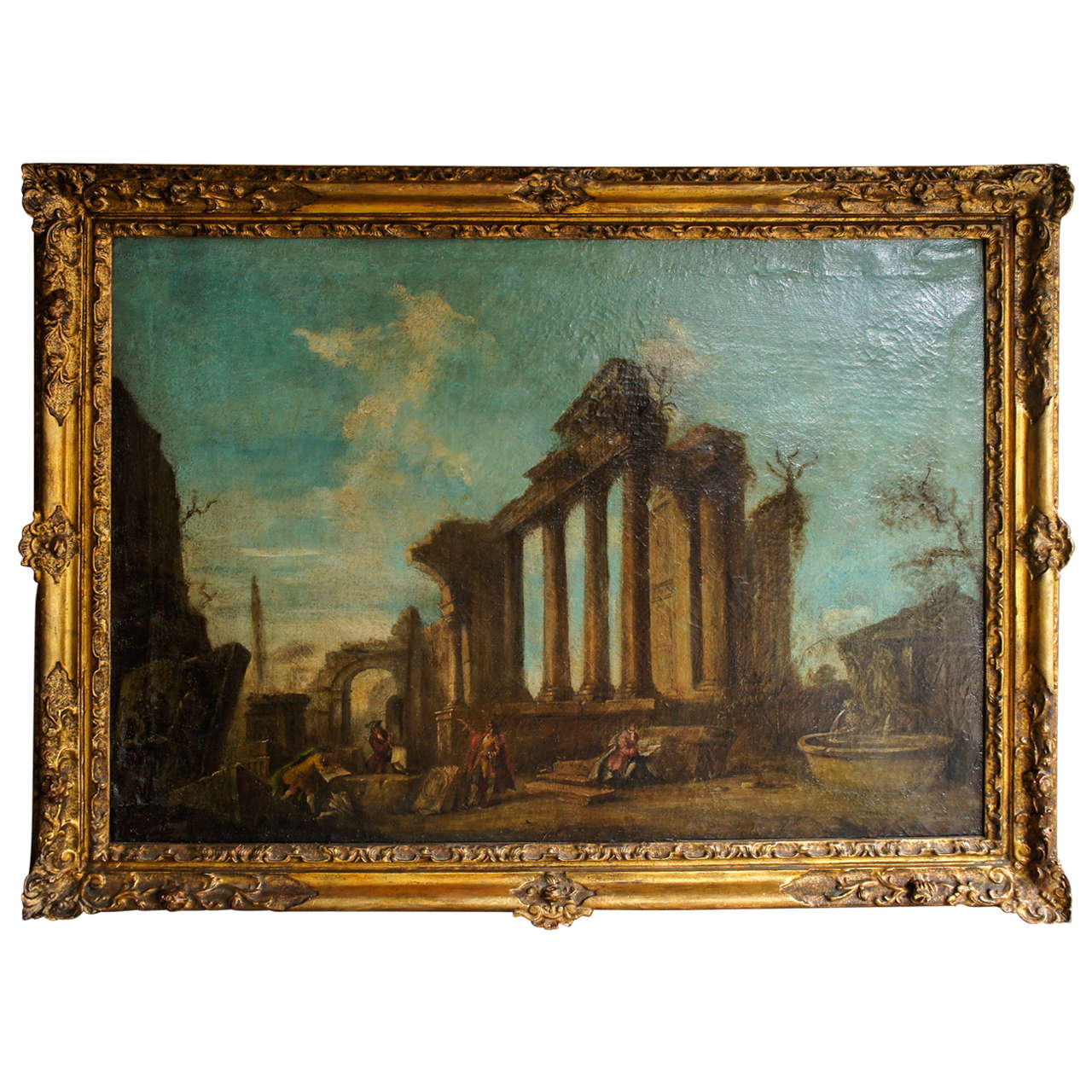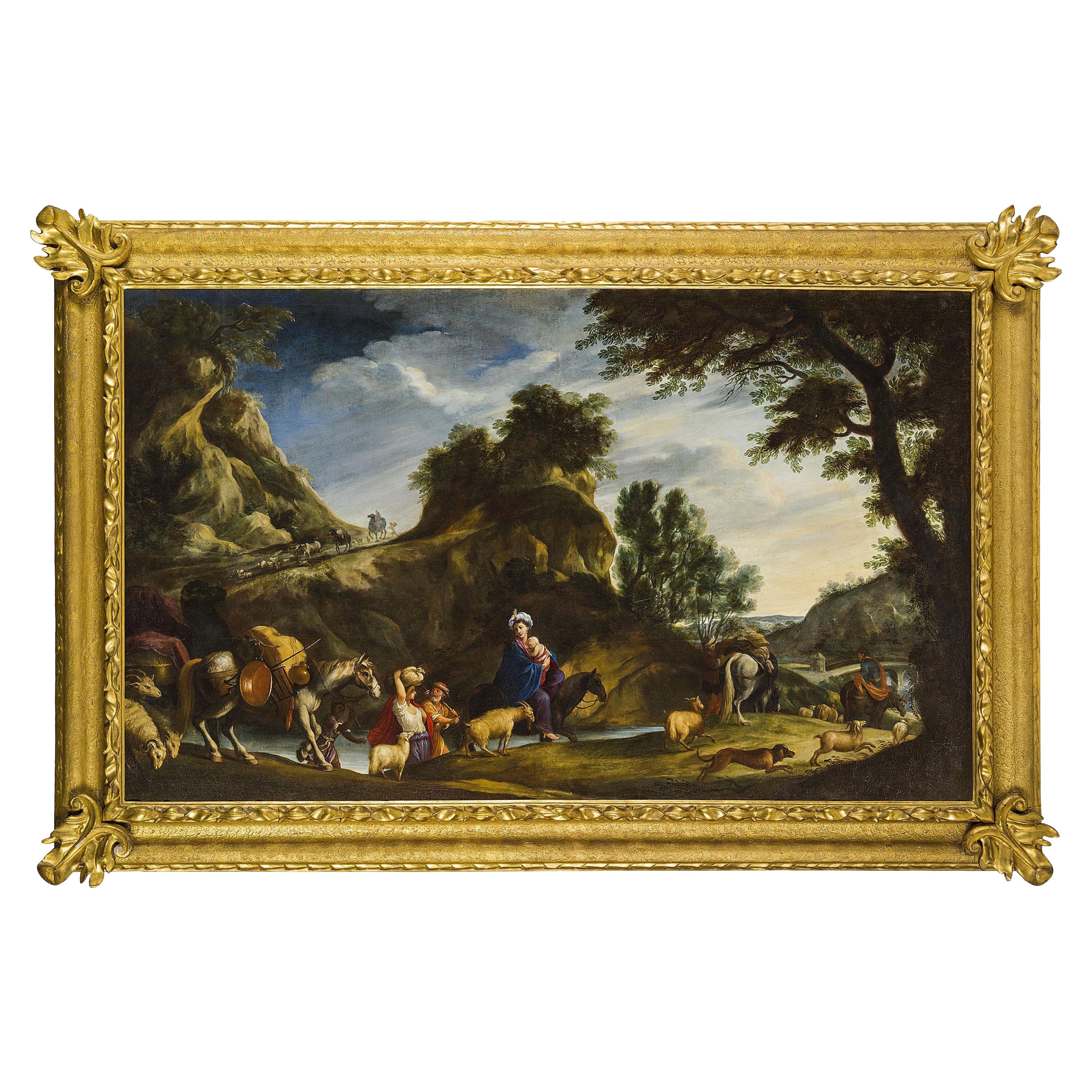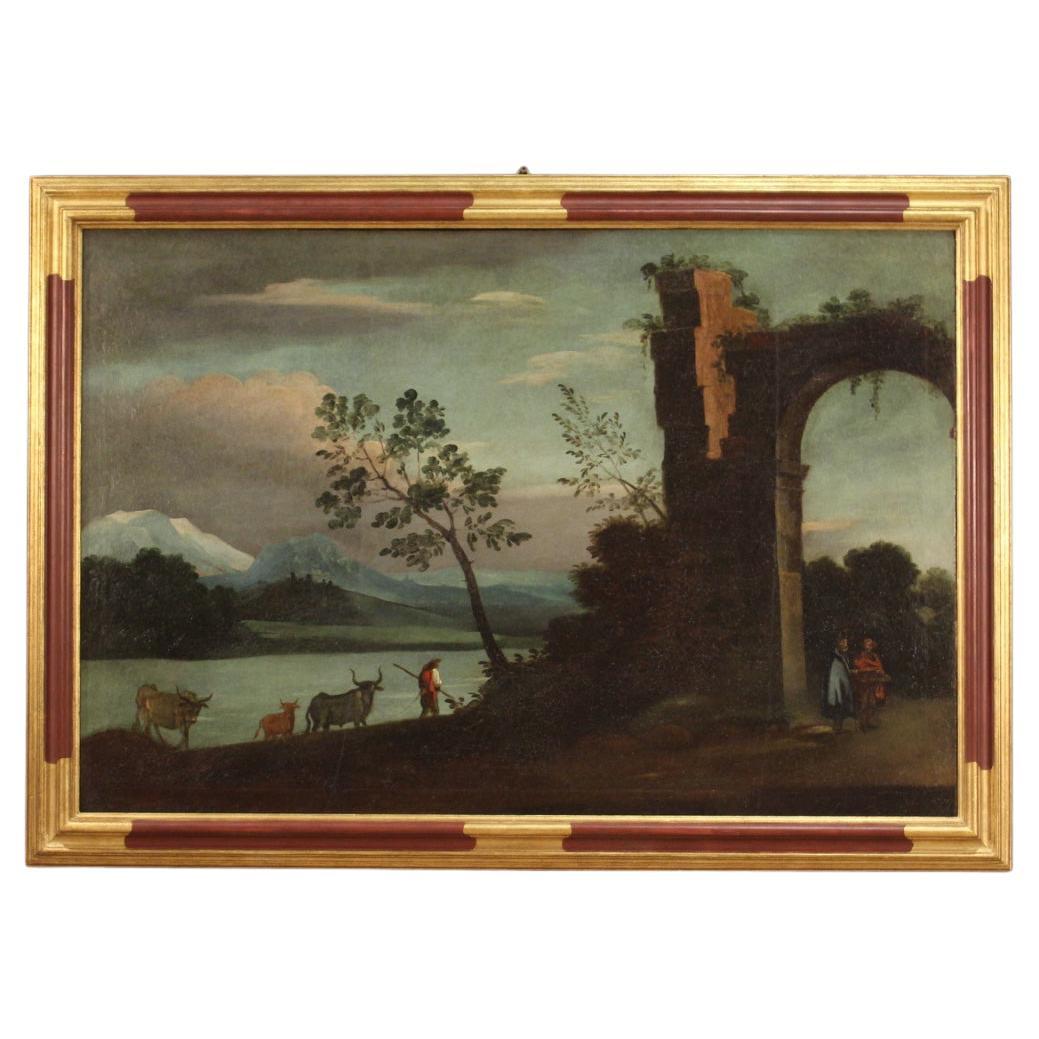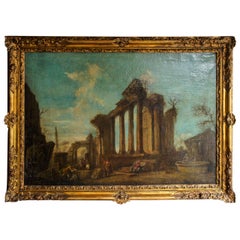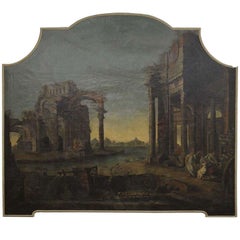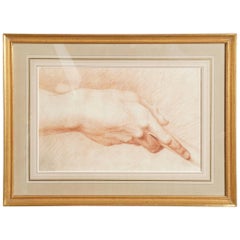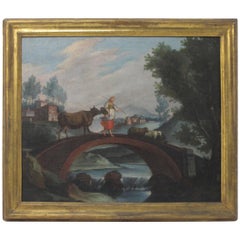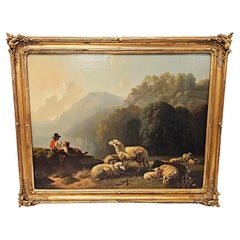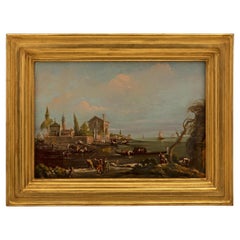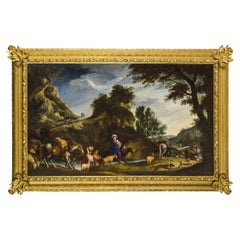Items Similar to A late 18th Century Italian Painting
Want more images or videos?
Request additional images or videos from the seller
1 of 10
A late 18th Century Italian Painting
$4,150
£3,188.29
€3,663.31
CA$5,837.49
A$6,558.16
CHF 3,426.65
MX$80,045.38
NOK 43,508.41
SEK 40,954
DKK 27,336.98
About the Item
This lovely and decorative painting of peasants in a bucolic setting with numerous farm animals is typical of the period and is designed to illustrate happier moments and a getting back to nature that so many aristocratic families longed for in there country residences. Thought dark in this photo the painting is finely detailed and the colors are bright and lovely ( for a more accurate likeness see image 5). The painting has been relined and there is a small but undetectable chipping to the paint in the lower section of the painting. The frame in a finely detailed old world style is of the late 19th or early 20th century and is made of wood and gesso with old gilding.
- Dimensions:Height: 32 in (81.28 cm)Width: 45 in (114.3 cm)Depth: 3 in (7.62 cm)
- Materials and Techniques:
- Place of Origin:
- Period:
- Date of Manufacture:Circa 1790
- Condition:Additions or alterations made to the original. Wear consistent with age and use. Minor losses. The painting is as found but in a ready to use condition with a small chip to the paint at the bottom center of the painting. The frame has some cracking to the gesso areas and rub thrus to the gilding but all of this is expected wear for an object.
- Seller Location:Hudson, NY
- Reference Number:1stDibs: 1010188113702
About the Seller
4.5
Vetted Professional Seller
Every seller passes strict standards for authenticity and reliability
Established in 1978
1stDibs seller since 2005
342 sales on 1stDibs
Typical response time: 12 hours
- ShippingRetrieving quote...Shipping from: hudson, NY
- Return Policy
Authenticity Guarantee
In the unlikely event there’s an issue with an item’s authenticity, contact us within 1 year for a full refund. DetailsMoney-Back Guarantee
If your item is not as described, is damaged in transit, or does not arrive, contact us within 7 days for a full refund. Details24-Hour Cancellation
You have a 24-hour grace period in which to reconsider your purchase, with no questions asked.Vetted Professional Sellers
Our world-class sellers must adhere to strict standards for service and quality, maintaining the integrity of our listings.Price-Match Guarantee
If you find that a seller listed the same item for a lower price elsewhere, we’ll match it.Trusted Global Delivery
Our best-in-class carrier network provides specialized shipping options worldwide, including custom delivery.More From This Seller
View All19th Century Italian Oil Painting in the Manner of Antonio Panini
Located in Hudson, NY
This fine old painting is a typical pastiche of the kind popular throughout Italy and the world in the 17th, 18th and 19th centuries. The most commonly associated artist who really m...
Category
Antique 19th Century Italian Baroque Revival Paintings
Materials
Canvas, Wood
A Monumental Roman Painting of Ancient Ruins and People
Located in Hudson, NY
This very large painting features as its main element ancient ruins, but also contains the bucolic elements and rusticated features so often associated w...
Category
Antique Late 18th Century Italian Paintings
Materials
Canvas, Paint, Wood
Fine Early 19th Century Academic Preparatory Drawing
Located in Hudson, NY
This very fine drawing in Sanguine is from the early 19th century. Made as a preparatory sketch concerning composition, musculature and shadow this work is unsigned but we have four ...
Category
Antique Early 19th Century French Charles X Drawings
Materials
Hardwood, Paper
Pair of 18th Century Dutch Painted Still Lifes on Panels
Located in Hudson, NY
The pair are painted on wood panel and done circa 1760 by a country artist working from life. Each composition is very similar but subtly different and incorporating different leaves...
Category
Antique Mid-18th Century Dutch Directoire Paintings
Materials
Wood
Two 19th Century Oil on Board Paintings After Pompeian Fresco
Located in Hudson, NY
These two paintings, considered tourist art produced in Naples Italy in the late 19th century, are reinterpretations of the frescos found in the excavations of Pompei. The painting i...
Category
Antique Late 19th Century Italian Paintings
Materials
Wood
Fine Large Late 18th Century or Early 19th Century French Academic Drawing
Located in Hudson, NY
This fine drawing while unsigned is an excellent example of sketch work done in sanguine as preparatory work for large finished paintings. Created in France during the days of artist...
Category
Antique Late 18th Century French Neoclassical Drawings
Materials
Wood, Paper
You May Also Like
18th Century Italian Painting
Located in San Francisco, CA
Charming old Italian village scene of a young girl with her cow and sheep. Oil on canvas in giltwood frame. The painting without the frame measures 19 3/4" high x 22 3/4" wide. Italy...
Category
Antique 18th Century Italian Paintings
Materials
Canvas
19th Century Oil on Canvas Painting
Located in Dublin, IE
A gorgeous 19th Century oil on canvas painting depicting a figural pastoral scene featuring a shepherd with his dog and flock of sheep within an exquisite mountain landscape with lus...
Category
Antique 19th Century English Paintings
Materials
Canvas, Giltwood, Paint
Italian 19th Century Oil on Canvas Painting
Located in West Palm Beach, FL
A beautiful Italian 19th century oil on canvas painting. The painting depicts a beautiful Italian scene of personages going about their day with charming boats and a house on the wat...
Category
Antique 19th Century Italian Paintings
Materials
Canvas, Giltwood
17th Century, Italian Painting by Pier Francesco Cittadini, Jacob and his Family
Located in IT
Pier Francesco Cittadini (Milan, 1616-Bologna, 1681)
"Jacob and his family go to Egypt"
Oil on canvas, cm 109 x 190 (canvas only)
The valuable painting, made in oil on canvas, depicts Jacob and his family go to Egypt and we believe it can be, given the high quality painting, autograph work of Italian Pier Francesco Cittadini (Italy Milan, 1616 - Bologna, 1681) made after 1647. The work, in excellent condition is accompanied by a coeval frame in wood finely carved and golden.
The scene depicted, which was confused with the Flight to Egypt in the past years, is instead identified with the biblical episode of Jacob’s journey. In the foreground, reading the painting from left to right, we see a caravan composed of animals, including donkeys, dromedaries, goats, dogs and horses and people, women, men and slaves, who carry on their journey along the banks of a river, following a path that to the right, would seem to lead to the through of a bridge. In addition to the watercourse is described an environment characterized by large rocks and impervious come far to cover the entire verticality of the canvas. On the left, in the distance, we see the tail of the caravan that runs along the steep path. Large trees enliven and harmonize the environment, as well as white and grey clouds characterize the predominantly clear sky and illuminated on the right by sunlight.
The story is told in the Bible, Book of Genesis, 30, 25, passage in which is described the flight of Jacob from Haran after the contrasts with Laban, father of his wife Rachel. Jacob is the third great patriarch of the Bible. From his descendants originate the twelve generations of the people of Israel. He is the son of Isaac and Rebekah, who led him to flee from the wrath of Esau to Haran to seek refuge from his brother, Laban. At his uncle’s house Jacob met his daughter Rachel. As soon as he saw his cousin, Jacob was taken. Jacob will stay seven years in the service of Laban to marry his beloved Rachel. But Laban, with a deception, will give him in marriage first Lia, the least beautiful eldest daughter, and only after another seven years the splendid Rachel. From his first wife he will have several children, while Rachel will give birth to the beloved son, Joseph, who will become viceroy of Egypt.
After years of service, Jacob asked to be paid with every dark-coloured garment among the sheep and every spotted and dotted garment among the goats. Laban accepted and sent away from his sons all the leaders of that kind. So Jacob took fresh branches of poplar, almond and plane tree, and flayed them, and put them in the troughs. The optical suggestion induced the goats and the sheep to conceive and give birth to dark, striped and dotted garments. He also ensured that all the strongest and healthiest leaders of the flock of Laban would drink near the barked branches, thus assuring a genetic superiority to his part of the flock. His flocks grew numerous and strong and he became richer than his relative, arousing envy. It was clear that Laban would not respect him much longer. At the suggestion of the Lord, Jacob decided to return to Canaan. Trying to avoid any possible dispute, he left with his family while Laban was absent for shearing sheep. But when, three days later, his uncle returned home, he became angry, feeling offended because Jacob had gone secretly and had not allowed him to greet his daughters and grandchildren. In addition, his teraphim, statuettes, or idols, which depicted the family deities, had disappeared. After 7 days of pursuit, Laban and his men reached Jacob’s group on Mount Gilead, in the mountainous region west of the Euphrates River, where his uncle and grandson had a stormy conversation. The younger man was outraged at being accused of stealing idols and told Labano to rummage through his family’s tents at will. Neither of them could know or even imagine that it was Rachel who took the idols and hid them in the saddle of the camel. During the search, she sat down firmly on the saddle, apologizing for not being able to get up, «because I usually have what happens to women» (Gen 31:35). So the loot wasn’t discovered.
The author of this work was inspired by the composition of an engraving by Stefano Della Bella (1610-1664) of circa 1647. The engraving by Stefano della Bella bears the title "Iacob sur ses vieux jours quitte sans fascherie pour voir son filz Ioseph, sa terre et sa patrie" and is signed on the bottom left "Stef. of the Beautiful In. et fe." while on the right it is declared "Cum privil. Regis", that is with license of the king.
Stefano Della Bella (Italy - Florence, May 18, 1610-Florence, July 12, 1664) was born in a family of painters, sculptors and goldsmiths and was left early orphan of his father sculptor, he dedicated himself first to the art of goldsmith at the school of Giovanni Benedetto Castiglione and Gasparo Mola, then turning his attention to drawing and engraving. He soon began drawing figures and copying the etchings of Jacques Callot, which inspired his early works. Under the protection of the Medici, in particular of Don Lorenzo, cadet son of Grand Duke Ferdinand I, Della Bella has the opportunity to make study trips to Rome, where he stayed from 1633-1636; In Rome he met French engravers and publishers of prints such as Israël Henriet and François Langlois, who influenced his decision to move to Paris in 1639, four years after the death of Callot. In Paris he soon reached, thanks to the engravings commissioned by Cardinal Richelieu, the success also worldly; he frequented courtiers, theatre artists and writers, while refusing too oppressive honors. In 1646-1647 he continued his travels in the Netherlands to Amsterdam, Antwerp and Dordrecht. He returned to Florence in 1650 and resumed working under the protection of the Medici court, working for his patrons. In 1656 he became a member of the Academy of Apatists.
The painting object of this study is reasonably attributable to Pier Francesco Cittadini, or Pierfrancesco Cittadini, called the Milanese or the Franceschino (Italy - Milan, 1616-Bologna, 1681) as some exemplary stylistic comparisons proposed to follow can prove.
Pier Francesco Cittadini was an Italian baroque painter, mainly active in Bologna.
His artistic training first took place with the painter Daniele Crespi...
Category
Antique Mid-17th Century European Baroque Paintings
Materials
Canvas, Giltwood
18th Century Oil on Canvas Italian Antique Landscape Painting, 1750
Located in Vicoforte, Piedmont
Antique Italian painting from 18th century. Framework oil on canvas, on the first canvas, depicting a view with characters, animals and ruins of good pictorial quality. Large size fr...
Category
Antique 1750s Italian Paintings
Materials
Canvas
17th Century Oil on Canvas Italian Bucolic Landscape Painting, 1680
Located in Vicoforte, Piedmont
Roman school of the second half of the 17th century. Oil painting on canvas depicting a wonderful pastoral scene with figures and animals at the fountain. In the center of the painti...
Category
Antique 1680s Italian Paintings
Materials
Canvas
More Ways To Browse
Antique Wood Filing Cabinet
Arch China Cabinet
Archangel Michael
Arched China Cabinet
Art Deco Metal Bed
Asian Hand Carved Trunk
Audio Cabinet
Austrian Bronze Dog
Bakery Display Used
Bed Of Nails
Beer Table
Bird Sculpture Sterling Silver
Bizen Pottery
Brienz Bear
Brigitte Enders
British Campaign Chest
Bronze Desk Statue
Bronze Falcon
